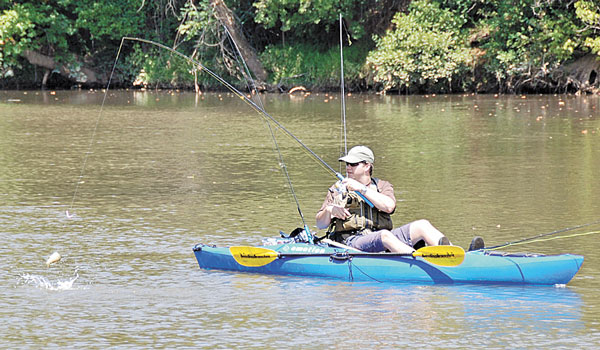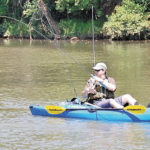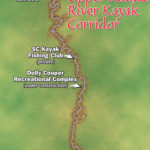
On May 8, 2009, the 13.55-mile Greenville Hospital System Swamp Rabbit Tram Trail was opened for business. The “Swamp Rabbit Trail,” as it’s known, was an effort by the Greenville County Recreation District to turn “rails into trails” by converting the old Carolina, Knoxville, and Western Railway line into a healthy greenway bicycle/walking path. For the most part, including sponsorship by the Greenville Hospital System, the trailway has been a success and a healthy link between the towns of Greenville and Travelers Rest. It may be a stretch, but this community effort hasn’t gone unnoticed by neighboring counties.
Turning our attention to the Upper Saluda River, it rises in the Upstate mountains of Greenville and Pickens counties and winds through the rolling hills, where it once and sometimes remains a source of hydro-electric power for several mill villages as it makes its way to Lake Greenwood.
Back in the day, we used to call it the “Polluta River” because it was so dirty, presumably from sewage-water dumps and before the enactment of the Clean Water Act. Today, there remain those who would infringe on the Saluda’s water quality in the name of private development.
The Saluda is on the EPA’s “watch list” for endangered rivers, presumably for the uncertainty of its future, rather than its current problems. As for the future of the Saluda, Matt Schell of the neighboring Anderson County Parks and Recreation department believes it’s bright.
Schell’s department is interested in helping preserve access points on the Saluda and adding them to the “Kayak Corridor,” a 5-county project designed to promote eco-tourism in the Upstate.
“This is a collaborative effort between the counties that border the Saluda,” Schell said. “We have the potential of linking 43 miles of the Saluda together in an access-friendly paddle trail. It is a project that has been a long time in planning and bringing into implementation. Funding for the individual access and portage sites is a matter of garnering interest and having each county add the project into their capital-improvement plans.”
Schell credits groups like the South Carolina Kayak Fishing Club with fueling the potential for projects like the Kayak Corridor, which was the brainchild of fishermen Chris Johnson and Travis Duncan, both of Powdersville. Initially, Johnson discovered an abandoned 4-acre access point to the Saluda and petitioned the owner to lease the property to him in return for cleaning up the land and policing it for vandalism and trash dumping. With more work than just the two could manage, they started the kayak-fishing club under a similar guise similar as many deer clubs: pay your dues, get a key to the gate, show up on work days and enjoy the resource.
“We named it the South Carolina Kayak Fishing Club to tie it in to the popular kayak fishing website run by Rick Ammons,” Johnson said. “The two really aren’t connected, but Rick did put a forum about the club on his website so people could communicate about it.”
The appeal of the Saluda for kayak anglers is its close proximity to the Upstate, plus some pretty decent catch rates for largemouth bass, bream and catfish. While the mountainous, cold-water section of the Saluda gets stockings of rainbow trout, most of the club’s focus is on the warmwater section, which begins just below Saluda Lake dam.
“From the Saluda Dam, it’s about eight miles down to the private ramp at the South Carolina Kayak Fishing Club,” said Travis Duncan, the club’s president. “From there, it’s another 2.2 miles to the public access at the Dolly Cooper Complex being built by Anderson County. After that, it’s about another six miles before you get to the Piedmont Reservoir in Piedmont. There’s a dirt ramp there where you can either pull out or port and keep going down to Pelzer.”
Duncan said it’s not unusual to float a half-day from one point to another or paddle upstream a mile or two and float back and catch 50 to 60 fish in an outing. The bag will be mixed mostly between largemouth bass and bream, with the occasional channel catfish for good measure. It’s definitely not a trophy fishery; most of the bass will be of the 10- to 12-inch variety, and half that for the bream, but it’s a light-tackle paradise.
“I never fish with anything over 6-pound test,” Duncan said. “You want to match the tackle to the fish, so I use all ultralight outfits. The pattern is also pretty simple. We float the river and fan-cast to everything that looks like it might hold a fish. Most of them will be hanging out around blowdowns or under the edge of an undercut bank.”
When it comes to baits, Duncan finds it much easier to stick with all artificials. Tiny crankbaits, Beetle Spins and plastic jigs all work well. He said his secret bait for catching any fish that swims in the Saluda is a Fish Stalker Slab Tail jig on a 1/32nd-ounce Roadrunner head.
According to Duncan, the fishing is mostly catch-and-release. Few anglers are interested in loading up on hand-sized fish. For he and the other members of the SCKFC, it’s all about a relaxing outing of fishing, enjoying the scenery, and Paddling Palmetto.
For more information about the SCKFC, visit www.sckayakfishing.com, go to the Forums sections and view the SC Kayak Fishing Club-Saluda River forum.






Be the first to comment